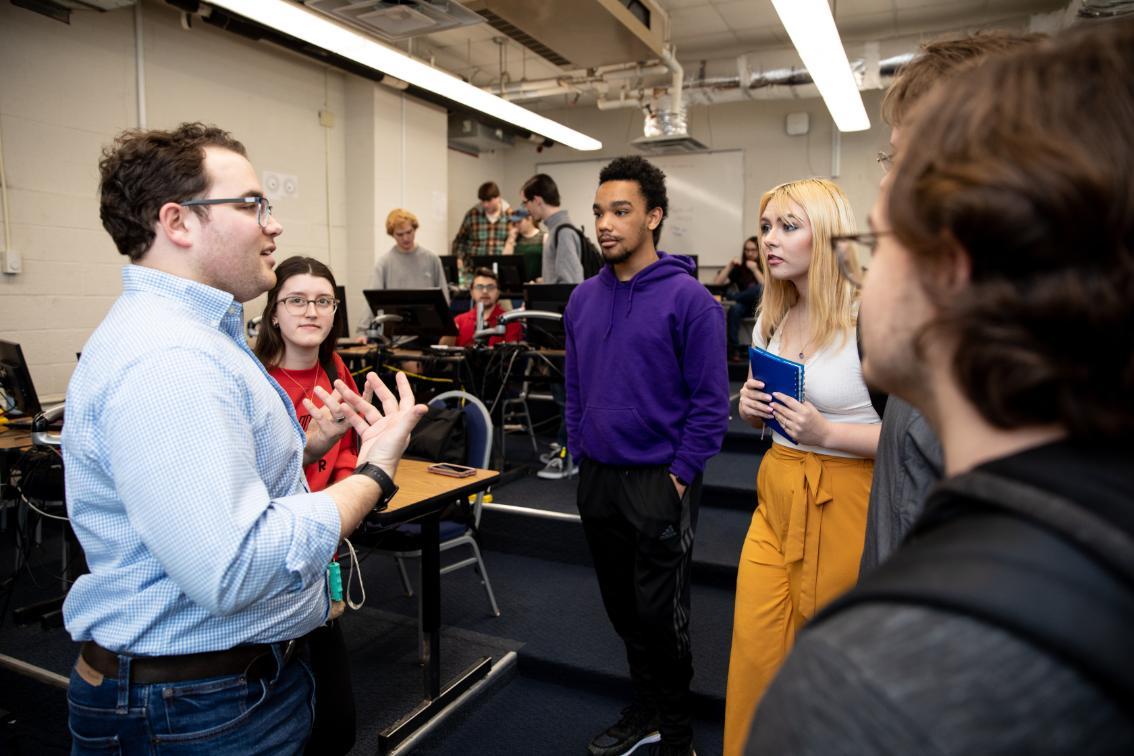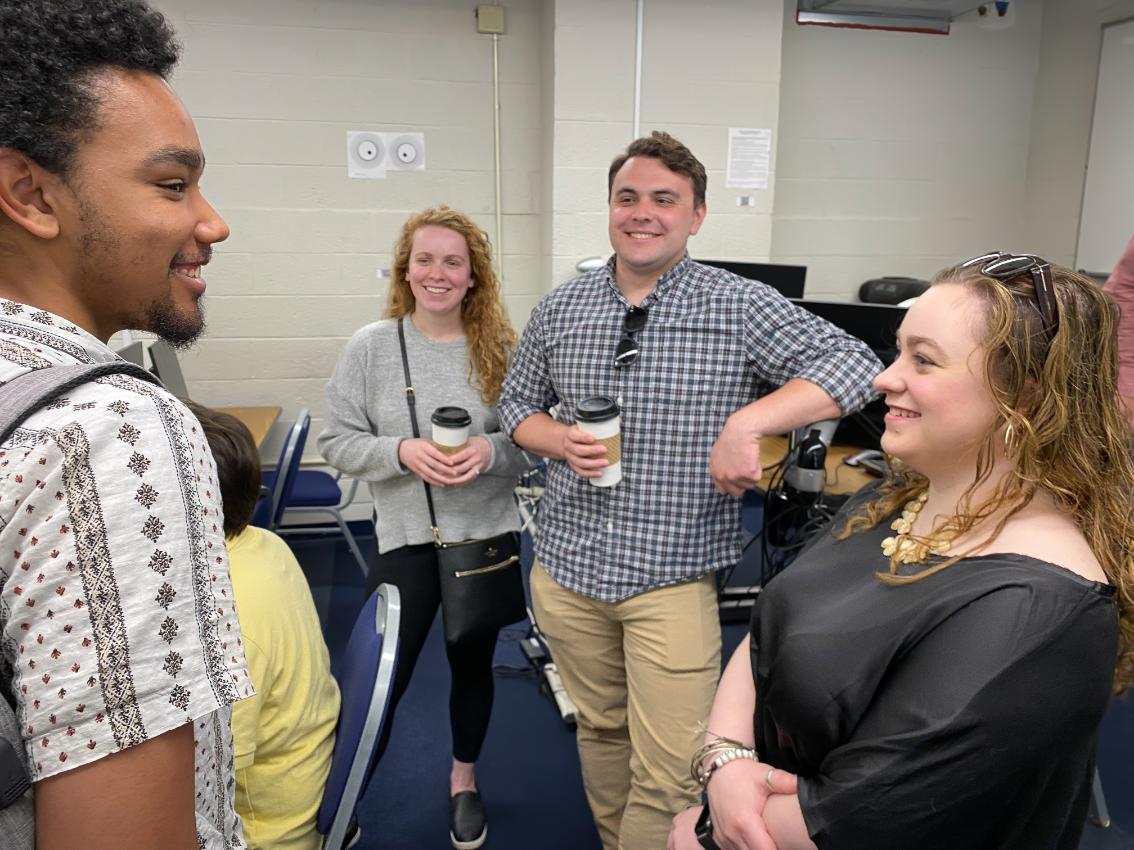

How do you get nine busy software engineers, programmers and product managers to volunteer their time over a whole semester to bring the real world into a computer science class?
If you’re Dr. Robert Marmorstein and those professionals are Longwood alums, it’s simple. First make sure you do everything possible to prepare your students for successful careers. Do such a good job that years later they vividly remember—and continue to be grateful for—what they learned in your classes.
Then just ask.
“Dr. Marmorstein’s dedication to going above and beyond for his students left a lasting impression on me,” said Tyler Jones ’18, one of the nine volunteers who worked with Longwood students in Marmorstein’s computer science senior seminar over the spring semester.
Dr. Marmorstein’s dedication to going above and beyond for his students left a lasting impression on me.
Tyler Jones ’18 Tweet This
Now a lead software engineer at the Naval Surface Warfare Center Dahlgren Division, Jones said he saw his former professor’s invitation to help out as “a way to express my gratitude and give back for the invaluable support he provided during my time at Longwood.”
It was also a chance for Jones and the other volunteers, whose positions involve product development, to sit on the other side of the table. They got to be the “clients” during the seminar, each working with one of the three student teams charged with developing a complex software product. For example, one team worked on a web application of the word game Fictionary Dictionary, and another continued work on a project called LightBot, whose purpose is to solve the problems created by poorly placed motion sensors in the computer lab that turn the lights off at inconvenient times.
The alums had remote meetings with students every other week to outline their needs for the products, assess progress, give feedback and provide direction. It’s an experience that is strikingly close to what the students, all computer science majors, will face in the real world.
It’s hard to simulate this kind of communication in an academic space, but I think it’s close. It’s really good practice in communication.
Katie Boesel ’23 Tweet This
Katie Boesel ’23, who worked on the Fictionary Dictionary project, interviewed for the job of project owner of her team and got it. (That’s right, she had to prove she was the best-qualified person for the job—just like in the real world.) In her role, she was the person who spoke directly with the clients, aka the alumni volunteers.
At the end of the semester, terms like product owner (product requirements lead), scrum master (the liaison between the product owner and the rest of the team), sprint (two-week intervals with specific targets for assessing progress) and scope creep (the pitfall of adding goals that distract from the main objective) rolled off her tongue as if they’d been part of her vocabulary since childhood.
As the person ultimately responsible for successful completion of the project, Boesel said she was a little nervous at first, but she soon began to enjoy being in a leadership role and helping to keep the project on track.
“We’re practicing agile daily stand-up progress meetings, 15-minute high-level discussions of the project for the whole team. We’re doing regular product demonstrations. We’re researching as we program. The process is very integrated,” she said, adding that learning how to communicate with clients and team members is a very big part of what students are learning.
“It’s hard to simulate this kind of communication in an academic space, but I think it’s close. It’s really good practice in communication,” she said.

Marmorstein would no doubt be happy to hear her say that.
“In their other classes, students learn technical skills and algorithmic theory,” he said. “The primary goal for this class is for students to learn the communication and ‘soft’ skills that give those technical skills context.”
That real-world element is particularly important, he added.
“The experience the alumni bring to the table gives the students a perspective they don’t see elsewhere in the computer science curriculum,” said Marmorstein, an associate professor of computer science. “And the students can relate to them in a different way than they relate to a professor, which encourages engagement and deeper learning. The computer science program, like other academic areas at Longwood, has a network of incredibly talented and experienced alumni who are eager to give back to the program and share their experiences with current students.”
Alumni Volunteers
Computer Science Senior Seminar
- Bridgett Burg '18
Software Developer, Naval Surface Warfare Center Dahlgren Division - Susan Chatfield '19
Programmer, High Rez Consulting, Inc. - Nathan Helms '22
Programmer Associate, General Dynamics Information Technology - Tyler Jones '18
Lead Software Engineer, Naval Surface Warfare Center Dahlgren Division - Daniel Millson '20
Senior Software Developer, Capital One - Patrick O'Hare '13
Scrum Master, Kinsale Insurance - Julia Robinette '09
Product Manager, Northrop Grumman - Austin Youngerman '20
Software Engineer, Whiteboard Federal Technologies - Tyler Zamora-Carden '19
Scientist, Naval Surface Warfare Center Dahlgren Division
Boesel couldn’t agree more: “The alumni have been absolutely fantastic. I’ve enjoyed every second of working with them, and I think this experience will give us a leg up in the real world.”
Bridgett Burg ’18, a technical product owner at the Naval Surface Warfare Center Dahlgren Division and one of the clients for Boesel’s team, was excited to see how much the students were learning throughout the seminar.
“Seeing the growth of the team over the semester was super exciting. The team would take our feedback, and we would actively see them applying it,” she said. One of four alums who traveled to campus for the students’ final presentations, Burg is responsible for include driving technical and product vision for one of her project’s agile teams at NSWCDD.
Tyler Jones also was a client for Boesel’s team.
“Katie was deeply engaged throughout the semester, approaching every interaction as a chance to grow and learn,” he said. “Knowing that you played a role in that process makes the investment worth the time.”
